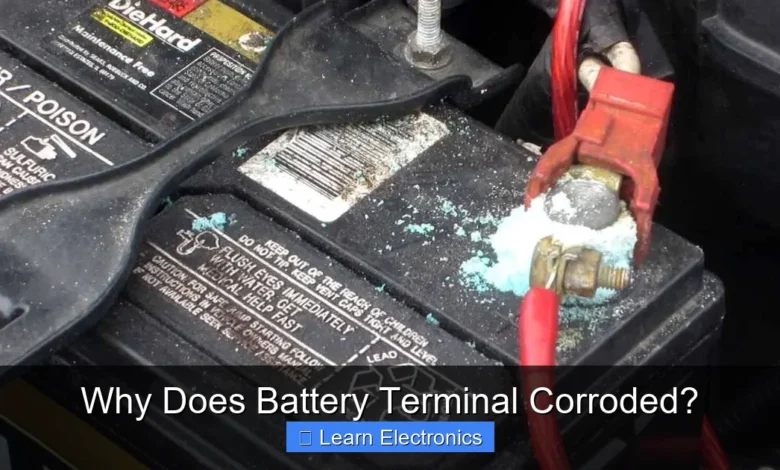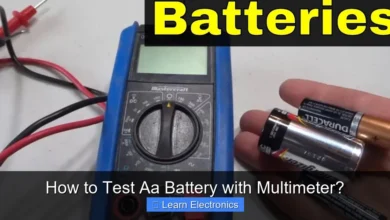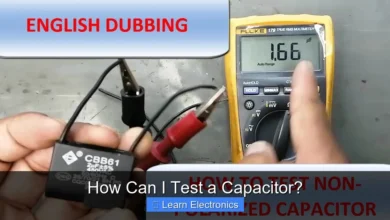Why Does Battery Terminal Corroded?

Why Does Battery Terminal Corroded? This common issue primarily stems from the electrochemical reactions between battery acid, metal terminals, and atmospheric elements, leading to the formation of crystalline deposits. This corrosive process not only diminishes battery performance but can also indicate underlying problems with your vehicle’s electrical system, impacting reliability and safety.
Understanding the root causes of this buildup is crucial for effective prevention and maintenance. By identifying the specific factors that contribute to battery terminal corrosion, vehicle owners can take proactive steps to extend battery life and ensure consistent electrical system functionality.
Quick Answers to Common Questions
Why does my battery terminal corrode in the first place?
Battery terminal corrosion is often caused by hydrogen gas escaping from the battery vents and reacting with the metal terminals and surrounding air. This reaction creates the tell-tale lead sulfate deposits you see, signaling a chemical interaction often due to heat, overcharging, or simple wear and tear.
What does that white or blue fuzzy stuff on my battery terminals actually mean?
That distinctive white or bluish-green fuzzy substance is corrosion, primarily lead sulfate or copper sulfate, forming due to a chemical reaction. It’s a clear sign that acid fumes are escaping the battery and reacting with the metal, which can impede electrical flow.
Can I just ignore battery terminal corrosion, or is it a big deal?
Definitely don’t ignore it! Battery terminal corrosion creates resistance, making it harder for your battery to deliver power, which can lead to starting problems and even shorten the lifespan of your battery or electrical components. It’s always best to address it promptly to maintain optimal performance.
📑 Table of Contents
The Chemistry Behind Terminal Corrosion
Battery terminals, typically made of lead or a lead alloy, are susceptible to corrosion due to their proximity to the battery’s electrolyte and exposure to the surrounding environment. The fundamental reason for the problem is a series of chemical reactions.
Electrolyte Vapors and Acid Leaks
- Sulfuric Acid Interaction: Standard lead-acid batteries contain a solution of sulfuric acid and distilled water. While sealed, tiny amounts of hydrogen gas and sulfuric acid vapor can escape, especially during charging, through small vents designed to prevent pressure buildup.
- Reaction with Metal: These escaping acid vapors react with the copper and lead alloys of the battery terminals and clamps. When sulfuric acid reacts with lead, it forms lead sulfate, a white powdery substance. If it reacts with copper (often found in the battery cable clamps), it can form copper sulfate, which appears as blue or green crystals.
- Cracks and Leaks: Over time, the battery casing can develop hairline cracks, particularly around the terminals due to vibrations or excessive tightening of cable clamps. This allows the liquid electrolyte to seep out and directly contact the terminals and surrounding metal, significantly accelerating the corrosive process.
Atmospheric Influence and Galvanic Corrosion
- Moisture and Oxygen: The presence of moisture (from humidity or rain) and oxygen in the air acts as catalysts, accelerating the chemical reactions that form corrosive deposits. Water facilitates the movement of ions, making it easier for corrosion to occur.
- Dissimilar Metals: Galvanic corrosion can occur when two dissimilar metals (like lead terminals and copper cable clamps) are in contact within an electrolyte solution (even just atmospheric moisture can act as one). An electrical potential difference between the metals causes the less noble metal (often the lead terminal) to corrode at an accelerated rate as electrons flow from it to the more noble metal.
Common Causes of Corroded Battery Terminals
While the chemical reactions are universal, several practical factors contribute to how and why corrosion manifests on battery terminals.
Overcharging and Undercharging
- Overcharging: When a battery is overcharged, it heats up, causing the electrolyte to boil and convert more rapidly into gas. This increased gassing pushes more sulfuric acid vapors out through the battery vents, dramatically increasing the rate of terminal oxidization. This often appears as white, powdery corrosion on the positive terminal.
- Undercharging: Consistently undercharging a battery can lead to sulfation within the battery cells, reducing its efficiency. While not a direct cause of external terminal corrosion, an underperforming battery might be stressed more, leading to higher internal temperatures during its limited charge cycles, which can indirectly contribute to gassing and vapor leakage.
Loose Battery Connections and Damage
- Resistance and Heat: Loose battery cable connections create resistance in the electrical circuit. This resistance generates heat, which can cause the battery acid to vaporize more rapidly and leak around the terminals. The heat also exacerbates any existing chemical reactions.
- Vibration Damage: Constant vibrations from vehicle movement can loosen terminal connections over time and even cause micro-fractures in the battery casing around the terminals, providing pathways for acid leakage. Physical damage to the battery case from impacts can also directly cause leaks.
Age and Wear of the Battery
- Seals Degradation: As batteries age, the seals around the terminals can degrade and become less effective, allowing more acid vapor or even liquid electrolyte to escape.
- Internal Breakdown: Older batteries are more prone to internal resistance and inefficiency, which can lead to increased heat generation and gassing, accelerating the corrosion process on the terminals.
Recognizing the Signs and Types of Corrosion
Identifying the type and location of corrosion can offer clues about its underlying cause.
White, Blue, or Green Powdery Deposits
- White Deposits: Most commonly found on the positive terminal, this is usually lead sulfate. It’s often indicative of overcharging or sulfuric acid leaking and reacting with the lead terminal.
- Blue/Green Deposits: Typically found on the negative terminal or the cable clamp itself, these are usually copper sulfate. This suggests that the copper in the cable clamp is reacting with escaping hydrogen gas, moisture, and acid vapors. It can also point to issues with undercharging or general exposure to atmospheric elements.
Reddish-Brown (Rust-like) Corrosion
- Iron Oxide: If you see reddish-brown corrosion, it’s often iron oxide, commonly known as rust. This indicates that a steel component (like a battery hold-down clamp or tray) near the battery has been exposed to the corrosive acid and moisture. While not directly on the terminal, its presence signifies a highly corrosive environment around the battery.
The Impact of Corrosion on Vehicle Performance
Corroded battery terminals are more than just an unsightly mess; they directly hinder the battery’s ability to perform its essential functions, leading to a host of operational problems.
Starting Issues
- Increased Resistance: Corrosion acts as an electrical insulator, significantly increasing the resistance in the circuit between the battery terminals and the vehicle’s electrical system.
- Reduced Current Flow: When resistance is high, the battery cannot deliver the necessary surge of current to the starter motor. This results in slow cranking, clicking sounds, or a complete failure to start the vehicle.
Charging Problems
- Alternator Overwork: A corroded connection can impede the alternator’s ability to fully recharge the battery. The alternator has to work harder to overcome the resistance, potentially shortening its lifespan.
- Undercharged Battery: Even if the alternator is functioning correctly, the resistance from corrosion can prevent the battery from receiving a full charge, leaving it constantly undercharged and prone to further sulfation.
Electrical System Malfunctions
- Erratic Electronics: Modern vehicles rely heavily on a stable electrical supply for their complex electronic control units (ECUs), sensors, and accessories. Corroded terminals can lead to fluctuating voltage, causing dashboard warning lights, erratic radio operation, power window issues, or even engine performance problems.
- Damage to Components: Persistent low voltage or spikes due to poor connections can stress and potentially damage sensitive electronic components throughout the vehicle.
Preventing Battery Terminal Corrosion
Proactive maintenance is the best defense against battery terminal corrosion. A few simple steps can significantly extend the life of your battery and prevent related electrical issues.
Regular Cleaning and Inspection
- Routine Checks: Inspect battery terminals regularly (e.g., during oil changes or every few months) for any signs of buildup.
- Cleaning Process:
- Always disconnect the negative terminal first, then the positive.
- Use a wire brush (a specialized battery terminal brush is ideal) and a solution of baking soda and water (about a tablespoon of baking soda per cup of water) to clean the terminals and cable clamps thoroughly.
- The baking soda neutralizes the sulfuric acid. Pour the mixture over the corroded areas; it will fizz as it neutralizes the acid.
- Rinse with clean water and dry thoroughly with a rag.
- Reconnect the positive terminal first, then the negative.
Using Anti-Corrosion Products
- Dielectric Grease: After cleaning and reconnecting, apply a thin layer of dielectric grease to the terminals and cable clamps. This grease creates a barrier that helps prevent moisture and acid vapors from reaching the metal.
- Anti-Corrosion Washers/Pads: Felt washers impregnated with anti-corrosion chemicals can be placed over the battery posts before connecting the cables. These provide an additional layer of protection against corrosive gases.
- Battery Terminal Sprays: Specific sprays designed to prevent corrosion are also available. These create a protective coating over the terminals.
Proper Battery Maintenance
- Secure Connections: Ensure that battery cables are tightly secured to the terminals. Do not overtighten, as this can damage the battery posts.
- Proper Charging: Avoid overcharging or undercharging the battery. If your vehicle experiences frequent charging issues, have the alternator and charging system checked by a professional.
- Ventilation: Ensure the battery compartment is adequately ventilated to allow any escaping gases to dissipate safely.
- Heat Protection: In hot climates, consider using a battery heat shield or ensuring proper ventilation around the battery to prevent excessive heat buildup, which can increase gassing.
Understanding Different Battery Types and Their Corrosion Tendencies
While lead-acid batteries are the primary culprits for external terminal corrosion, other battery types have different vulnerabilities.
Lead-Acid Batteries (Flooded)
- Highest Risk: These are the most common type and are highly susceptible to the corrosive process due to their liquid electrolyte and venting design. The escaping sulfuric acid vapors are the main cause of the corrosion phenomenon discussed.
- Maintenance Critical: Regular inspection, cleaning, and application of anti-corrosion treatments are most critical for these batteries.
AGM and Gel Batteries
- Reduced Risk: Absorbent Glass Mat (AGM) and Gel Cell batteries are sealed, “maintenance-free” types where the electrolyte is absorbed in mats or suspended in a gel. They are designed to minimize gassing and do not typically vent liquid acid.
- Still Possible: While significantly less common, corrosion can still occur. Extreme overcharging can cause these batteries to vent hydrogen gas, and if internal seals fail, some acid vapor could escape. Terminal corrosion on these types often points to a severe overcharging issue or physical damage to the battery’s casing.
Lithium-Ion Batteries
- Different Chemistry: Lithium-ion batteries used in some modern electric vehicles or for specific applications have entirely different chemistries and do not use sulfuric acid. Consequently, they do not suffer from the same type of terminal corrosion as lead-acid batteries.
- Other Issues: Any “corrosion” appearance on lithium-ion terminals would likely be oxidization of the terminal material itself due to environmental exposure, or residue from manufacturing, rather than acid-related deposits.
| Corrosion Type | Primary Location | Main Cause(s) | Indication |
|---|---|---|---|
| White Powdery | Positive Terminal | Overcharging, Acid Leaks | Lead sulfate buildup, common in flooded batteries. |
| Blue/Green Crystalline | Negative Terminal, Cable Clamp | Undercharging, Hydrogen gas + moisture + acid reaction | Copper sulfate buildup, often from cable clamp reaction. |
| Reddish-Brown (Rust) | Battery Tray, Hold-down | Acid exposure to steel components | Highly corrosive environment around the battery. |
| Minimal (AGM/Gel) | Terminals (rare) | Severe overcharging, physical damage | Indicates an extreme issue with sealed battery. |
Understanding why battery terminal corroded is the first step toward effective maintenance. The unsightly and problematic buildup on battery terminals is primarily a chemical byproduct of battery operation, exacerbated by various environmental and operational factors. From the electrochemical reactions involving sulfuric acid vapors to the impact of overcharging, loose connections, and battery age, several elements contribute to this common automotive issue.
Regular inspection, thorough cleaning using a baking soda solution, and the application of protective anti-corrosion products are your best defenses. By taking these proactive steps, you can prevent starting problems, electrical system malfunctions, and ensure a longer, more reliable lifespan for your vehicle’s battery. Prioritizing battery health translates directly into smoother, more dependable vehicle operation.
Frequently Asked Questions
What is the primary cause of battery terminal corrosion?
Battery terminal corrosion primarily occurs when hydrogen gas, released from the battery’s electrolyte during charging, reacts with the metal components of the terminals. This chemical reaction creates a white, green, or bluish powdery substance, which is often lead sulfate or copper sulfate.
What are the signs of corroded battery terminals, and what are the effects?
You’ll typically see a fuzzy, powdery white, green, or bluish build-up on or around the battery terminals and cable clamps. This corrosion acts as an insulator, impeding the flow of electrical current, which can lead to difficulty starting your vehicle, dimming lights, or issues with your charging system.
How do I safely clean corroded battery terminals?
To clean corroded battery terminals, first ensure the vehicle is off and disconnect the negative cable, then the positive. Mix baking soda with water to create a paste, apply it to the corrosion with a wire brush to neutralize the acid, then rinse with clean water and dry thoroughly.
What are some effective ways to prevent battery terminal corrosion?
After cleaning your battery terminals, you can apply a thin layer of dielectric grease, petroleum jelly, or a specialized anti-corrosion spray to the posts and cable clamps. Using anti-corrosion washers designed for battery terminals can also help create a protective barrier against future build-up.



